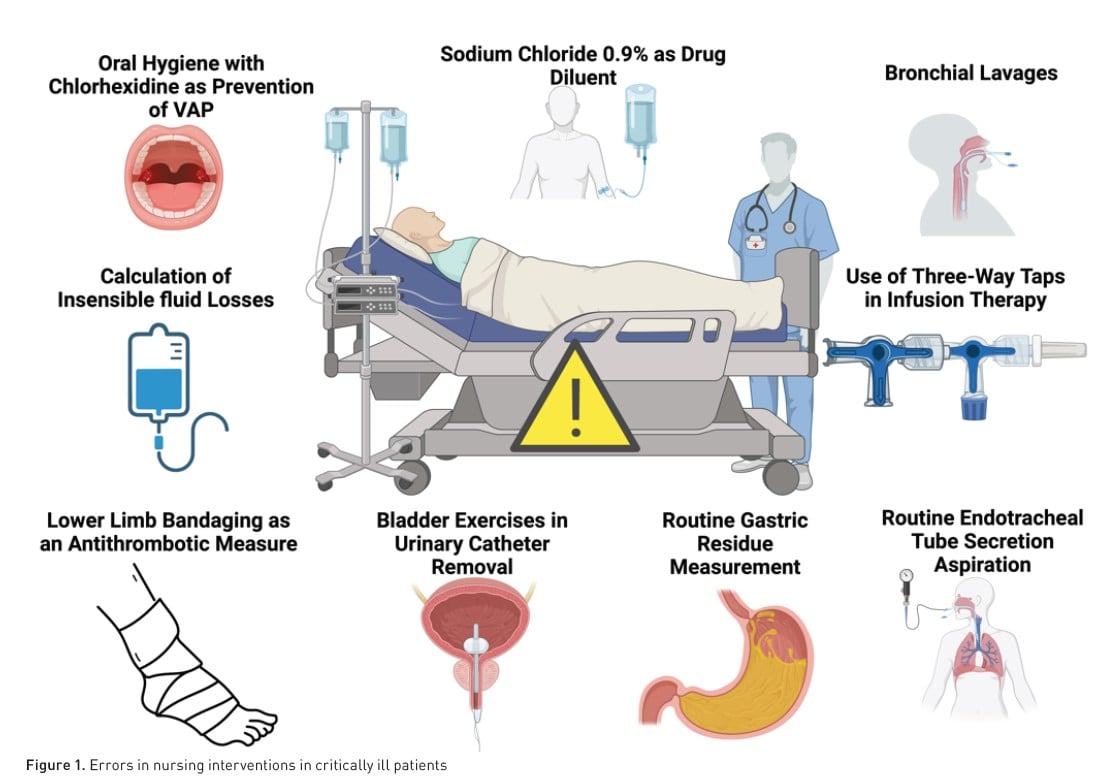ICU Management & Practice, Volume 24 - Issue 2, 2024
In the treatment of critically ill patients, evidence-based nursing practices are essential, highlighting the need for precision in procedural management. This discussion identifies nine common errors encountered in clinical practice.
Introduction
Patient care is the essence of the nursing profession, focusing on the preservation, restoration, and promotion of self-care, currently based on evidence-based nursing (EBN) established through solid research from various studies, thus shifting the paradigm from traditional or experiential practice (Campo and Klijn 2011).
The implementation of EBN as the process that enables the profession the ability to make decisions based on the application of the scientific method demands nursing professionals to develop research and allows them to substantiate the care provided to patients, strengthening the profession's autonomy (Rojas et al. 2020)
We will delve into nine errors in nursing management related to the care of critically ill patients.
Routine Endotracheal Tube Secretion Aspiration
In patients undergoing advanced airway management, the placement of an endotracheal tube impedes the glottis. This interference disrupts the natural expulsion of secretions by physiological means, such as an effective cough or the mucociliary clearance mechanism. As a result, endotracheal suction becomes a critical nursing intervention, essential for maintaining airway cleanliness and preventing obstruction (Blakeman et al. 2022).
Given its invasive nature, the aspiration of secretions carries a heightened risk of complications, including hypoxemia, trauma, cardiac arrest, and potentially fatal outcomes. Therefore, a thorough assessment is paramount to determine the necessity for suctioning. This assessment should meticulously seek specific indicators that suggest the need for aspiration. Key signs include desaturation, elevated airway pressure, decreased tidal volume, a sawtooth pattern in the flow/time curve, pulmonary rales upon chest auscultation, and the presence of visible secretions within the ventilatory circuit (Pinto et al. 2020).
When implementing the suction technique, adhering to best practice guidelines ensures patient safety and effectiveness of the procedure. These include:
- Suctioning should be performed based on clinical need rather than a routine schedule to avoid unnecessary risks.
- Rigorous hand hygiene is essential both before and after the procedure to prevent the transmission of infections.
- The suctioning process should not exceed a maximum duration of 15 seconds to minimise discomfort and potential harm to the patient.
- The suction pressure for adults should be carefully regulated between 80 to 150 mmHg to ensure efficacy while reducing the risk of trauma.
- Choosing a catheter of the correct size is crucial for the effectiveness of the suctioning process and to minimise discomfort.
- Maintaining the sterility of the catheter and ensuring the suction system remains closed throughout the procedure are imperative to prevent infection.
- Documentation of the suction procedure on the nursing sheet is vital for continuous patient care and monitoring.
Bronchial Lavages
The American Association for Respiratory Care (AARC) and the American Association of Critical Care Nurses (AACN) have advised against the routine employment of bronchial lavages (Blakeman et al. 2022). In a more recent development, Chang et al. (2023) undertook a systematic review to evaluate the advantages and disadvantages of employing 0.9% sodium chloride solution for bronchial lavage before performing endotracheal aspiration. The findings highlighted several concerns, including a reduction in oxygen saturation that notably prolonged the recovery time back to initial levels, a decrease in arterial pH, an increase in secretion volume, a rise in heart rate, and an elevation in systolic blood pressure. These results suggest significant physiological impacts from the use of bronchial lavages, underscoring the need for careful consideration of their application in clinical practice.
Oral Hygiene with Chlorhexidine as Prevention of VAP
The oral cavity serves as a conduit to the lower airways, highlighting a link between respiratory infections. Historically, chlorhexidine gluconate has been considered the benchmark for oral care and maintenance, particularly in preventing ventilator-associated pneumonia (VAP). However, recent observations have recorded adverse events stemming from its usage, including erosive oral lesions, ulcerations, and the formation of white and yellow plaques, alongside bleeding of the mucosa (Silva et al. 2021).
Oral hygiene remains a fundamental and non-negotiable aspect of patient care, applicable universally, regardless of whether a patient is undergoing advanced airway management. To ensure proper oral hygiene, recommendations include the mechanical brushing of teeth using standard toothpaste and the regular moistening of the oral cavity to maintain moisture levels (Labeau et al. 2021). These practices are critical not only for the prevention of respiratory infections but also for the overall well-being of patients.
Routine Gastric Residue Measurement
The ESPEN 2023 guidelines currently recommend an early start of artificial enteral nutrition within 48 hours after patient admission with the objective of reaching 100% of caloric intake within 3-7 days from the start of feeding (Singer et al. 2023).
Enteral feeding intolerance is a common complication in critically ill patients, defined as a gastrointestinal dysfunction that interrupts the prescribed feeding. Routine monitoring of gastric residue measurement is an obsolete practice as measurements often turn out to be inaccurate, influenced by factors related to the tube, patient, or nursing professional (Yasuda et al. 2021).
Continuous monitoring is associated with a lower nutrient intake and insufficient feeding, as well as causing a tube obstruction. ASPEN guidelines recommend a nursing assessment aimed at identifying signs and symptoms of intolerance, such as abdominal pain, abdominal distension, or vomiting.

Figure 1. Errors in nursing interventions in critically ill patients
Calculation of Insensible Fluid Losses
Insensible losses refer to the water eliminated imperceptibly through respiratory (pulmonary) and skin (cutaneous) routes, typically unnoticed and difficult to measure directly. To manage patient care effectively, a meticulous assessment of fluid balance, along with accurate documentation of fluid intake and output, is essential. Inaccuracies in this evaluation can lead to unnecessary fluid administration and misguided treatment strategies, potentially increasing the risk of mortality.
In their article "Controversies in Acute Kidney Injury: Effects of Fluid Overload on Outcome," Mehta and Bouchard (2011) elucidate that the daily fluid balance is calculated by the difference between fluid intake and excretion, typically excluding insensible losses. To streamline the evaluation of fluid overload, Granado and Mehta (2016) propose several interventions, including:
- Daily Fluid Balance: The discrepancy between total intakes and outputs, usually excluding insensible losses.
- Cumulative Fluid Balance: The aggregate of daily fluid balances throughout the duration of hospitalisation.
- Fluid Overload: Often indicative of conditions such as pulmonary or peripheral oedema.
- Fluid Accumulation: A state of positive fluid balance, which may or may not coincide with fluid overload.
- Percentage of Fluid Overload Adjusted to Body Weight: The cumulative fluid balance represented as a percentage relative to body weight.
Furthermore, we recommend not attempting to quantify insensible losses in fluid balances, as doing so is associated with incorrect negative balances and unjustified increases in fluid administration. This adjustment is crucial for maintaining accurate fluid balance assessments, thereby reducing the risk of complications associated with fluid overload and improving patient outcomes.
Bladder Exercises in Urinary Catheter Removal
Bladder catheterisation is frequently used in hospitalised patients, having established insertion criteria, especially the measurement of urinary output. Bladder exercises were first described in 1936, mainly consisting of strengthening the pelvic floor muscle to recover bladder function (Wang 2016; Ellahi 2021). It is currently recommended:
- To perform catheter removal without bladder exercises.
- Bladder exercises for 24 or 48 hours with a frequency of four hours of occlusion and five minutes of continuous drainage do not benefit the restoration of bladder function.
- There is no difference between occlusion and continuous drainage with the reinsertion of the bladder catheter.
- Bladder exercises are a risky practice generating complications in the urinary tract, urinary tract infections, and urinary incontinence up to 22.5%
The insertion of a urinary catheter should be reserved for patients with a clear clinical necessity; its indications are limited to specific conditions, such as the need for precise monitoring in patients who are unable to communicate, individuals in a state of shock, or those experiencing urinary retention. Once these conditions no longer apply, it is recommended that the catheter be removed promptly, foregoing any bladder exercises.
Lower Limb Bandaging as an Antithrombotic Measure
Critically ill patients are at an increased risk of developing deep vein thrombosis (DVT) in the lower limb veins; compression stockings are effective in preventing DVT in critically ill patients but not required in patients with a low-risk (Ejaz et al. 2018; Sachdev et al. 2018).
Within the clinical practice guideline for Prevention, Diagnosis, and Treatment of Venous Thromboembolic Disease in the Obstetric Patient, as a good practice point (GPP), it is not recommended to use lower limb bandaging as equivalent or substitute for compression stockings.
Use of Three-Way Taps in Infusion Therapy
The Centers for Disease Control and Prevention (CDC) in 2011 mentioned that three-way taps represent a focus of infection and a potential entry point for microorganisms into vascular accesses and administered fluids (O´Grady et al. 2011).
Curran, in 2016, recommends the use of extensions as an alternative to three-way taps, allowing:
- Minimisation of dead space, which will avoid drug interaction.
- A closed system allows easy and effective disinfection, minimising the entry of microorganisms.
- Minimisation of biofilm formation and microbial growth.
- Manipulation further away from the patient reduces the risk of mechanical phlebitis in short peripheral vascular accesses.
- Free fluid pathway, which allows optimal flushing.
Sodium Chloride 0.9% as Drug Diluent
The nursing role in the stages of the medication process, especially in the process of drug preparation, is fundamental in the prevention of adverse events derived from the ideal choice of diluent fluid.
Hypernatraemia (serum sodium [Na+], > 145 to 150 mmol/L) is generally caused by a positive sodium balance, often administered during infusion therapy as a diluent for parenteral drugs as well as to maintain vascular access patency using the SAS technique (Solution, Drug Administration, Solution) favouring the prevention of pharmacological incompatibilities (Choo et al. 2014).
Bihari et al. (2012) were the first to report that this could represent about 22% of the total Na+ load administered in 20 ICU patients, similar to the 22% coming from resuscitation and maintenance fluids. Indeed, diluting parenteral drugs in 0.9% saline solution and its use to keep catheters open can be modifiable risk factors for hypernatraemia because 5% dextrose in water can be used to dissolve many drugs and keep catheters open, thus partly avoiding Na+ overload.
Aoyagi et al. (2020) evaluated the impact on electrolyte imbalance, glycaemic control, incidence of kidney injury, and mortality in the adequate selection of the diluent to ensure proper intravenous therapy. The assessment of the diluent effect was performed before and after the change from sodium chloride 0.9% to glucose 5%, decreasing the incidence of hyperchloremia and hyperkalaemia without changes in glycaemic control; these changes highlight the magnitude of the problem regarding the appropriate selection of the diluent and its effects on hydroelectrolytic imbalances.
Conclusion
The importance of evidence-based nursing practices in the care of critically ill patients cannot be overstated. It encourages a shift from traditional methods to practices supported by scientific evidence, highlighting the necessity for accurate medication diluent selection, diligent oral hygiene, and effective management of respiratory secretions. This approach underscores the essential role of nursing in improving patient safety and clinical outcomes, advocating for continuous research and education to advance the quality of care and ensure patient safety in the intensive care unit.
Conflict of Interest
None.
References:
Aoyagi Y, Yoshida T, Uchino S et al. (2020) Saline versus 5% dextrose in water as a drug diluent for critically ill patients: a retrospective cohort study. Journal of Intensive Care. 8(1).
Bihari S, Ou J, Holt A, Bersten AD (2012) Inadvertent sodium loading in critically ill patients. Critical Care and Resuscitation. 14(1):33-37.
Blakeman T, Scott JB, Yoder M et al. (2022) AARC Clinical Practice Guidelines: Artificial Airway suctioning. Respiratory Care. 67(2):258-271.
Campo VR, Klijn TMP (2011) Enfermería basada en la evidencia y gestión del cuidado. Enfermería Global. 10(24):0.
Chang SJ, Kim E, Kwon YO et al. (2023) Benefits and harms of normal saline instillation before endotracheal suctioning in mechanically ventilated adult patients in intensive care units: A systematic literature review and meta-analysis. Intensive and Critical Care Nursing. 78:103477.
Choo W, Groeneveld ABJ, Driessen RH, Swart EL (2014) Normal saline to dilute parenteral drugs and to keep catheters open is a major and preventable source of hypernatremia acquired in the intensive care unit. Journal of Critical Care. 29(3):390-394.
Curran ET (2016) Needleless connectors: the vascular access catheter’s microbial gatekeeper. Journal of Infection Prevention. 17(5):234-240.
Ejaz A, Ahmed MM, Tasleem A et al. (2018) Thromboprophylaxis in Intensive care unit patients: A literature review. Cureus.
Ellahi A, Stewart F, Kidd EA et al. (2021) Strategies for the removal of short-term indwelling urethral catheters in adults. Cochrane Database Syst Rev. 6(6):CD004011
Granado RC, Mehta RL (2016) Fluid overload in the ICU: evaluation and management. BMC Nephrology. 17(1).
Labeau S, Conoscenti E, Blot S (2020) Less daily oral hygiene is more in the ICU: not sure. Intensive Care Medicine. 47(3):334-336.
Mehta RL, Bouchard J (2011) Controversies in Acute Kidney Injury: Effects of fluid overload on outcome. In Contributions To Nephrology. pp. 200-211.
O’Grady NP, Alexander M, Burns LA et al. (2011) Guidelines for the prevention of intravascular catheter-related infections. Europe PMC (PubMed Central). 52(9):e162-e193.
Pinto HJ, Dsilva F, Sanil TS (2019) Knowledge and Practices of Endotracheal Suctioning amongst Nursing Professionals: A Systematic Review. Indian Journal of Critical Care Medicine. 24(1):23–32.
Red Hospitalaria de Vigilancia Epidemiológica (RHOVE) (2022). Boletín Infecciones Asociadas a la Atención de la Salud (IAAS). Available at https://www.gob.mx/cms/uploads/attachment/file/808320/BOLETINRHOVECIERRE2022_FINAL.pdf
Rojas FR, Ceballos-Vásquez P, Muñoz LS (2020) Enfermería basada en la evidencia: un desafío pendiente. Index De Enfermería. e12574.
Sachdeva A, Dalton MN, Lees T (2018) Graduated compression stockings for prevention of deep vein thrombosis. Cochrane Database Syst Rev. 11(11):CD001484.
Silva PUJ, Paranhos LR, Meneses-Santos D et al. (2021) Combination of toothbrushing and chlorhexidine compared with exclusive use of chlorhexidine to reduce the risk of ventilator-associated pneumonia: A systematic review with meta-analysis. Clinics. 76:e2659.
Singer P, Blaser AR, Berger MM et al. (2023) ESPEN practical and partially revised guideline: Clinical nutrition in the intensive care unit. Clinical Nutrition. 42(9):1671-1689.
Yasuda H, Kondo N, Yamamoto R et al. (2021) Monitoring of gastric residual volume during enteral nutrition. Cochrane Database Syst Rev. 9(9):CD013335.
Wang L, Tsai M, Han C et al. (2016) Is bladder training by clamping before removal necessary for Short-Term Indwelling Urinary Catheter Inpatient? A Systematic Review and Meta-analysis. Asian Nursing Research. 10(3), 173-181.

























